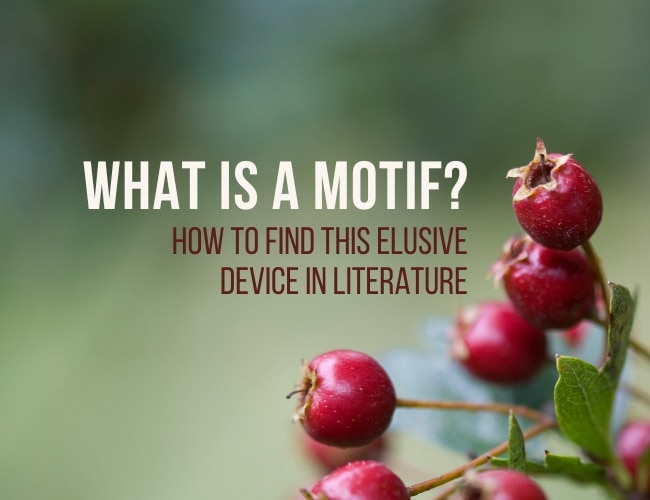What's a motif? In The Hunger Games, berries play a prominent role. During the game, deadly berries eliminate at least one participant, and Katniss uses the berries to subvert the government's purpose. But their presence goes beyond this. In fact, there are 56 references to berries of various kinds in the book.These references come at key moments in the plot.
What purpose do the berries serve to merit such a prominent place in the book? They are a motif.
“What's a motif?” I hear you say. Let's take a look.

Definition of a motif in literature
Merriam-Webster provides two relevant definitions of motif for our purposes:
1. a usually recurring salient thematic element (as in the arts), especially : a dominant idea or central theme.
2. a single or repeated design or color.
These provide us with a starting point for understanding a motif in literature, but let's begin with a visual or auditory motif before we get into more abstract ideas and how to apply them to literature.
In interior design, patterned wallpaper can, for example, have a leaf motif, a repeated design of leaves that stand out, as in the link here.
In the same way, music can have motifs. An example of a musical motif is the four-note “fate” motif from Beethoven's Symphony No. 5, which represents destiny and is woven throughout the entire composition.
In literature, motifs are images, objects, language, and behavior that are repeated throughout a work for a specific effect. They often connect to larger themes and ideas, often serving as a symbol.
Characteristics of a strong motif
What makes a strong motif?
A key characteristic of a motif is that it is repeated. If an item occurs only once or twice, it is not a motif, though it might be a symbol.
A second characteristic is that a motif connects to the story and highlights the theme, generates a mood, creates recurrent symbolism, or engages readers on a subconscious level, reinforcing deeper meanings, even when we don't see it at first.
Motifs should be distinctive and easily recognizable, but not too overt. If they become conscious, they may distract the reader.
The berries in The Hunger Games, mentioned in the introduction, are an example of a strong motif. The appear at key moments in the story, such as the opening image (when Katniss's normal life is established), at the inciting incident (when Katniss volunteers as tribute), at the transition to Scene Two (when Katniss crosses the threshold from District 12 to the Capital), and other places, including the climax and denouement, for a total of 56 mentions.
In Circe by Madeline Miller, blood and bleeding occur at every turning point, tying the motif to the plot. Other motifs include plants, which Circe uses for both good and ill, and the sea, which represents both a barrier and an escape. These motifs tie into the themes of the book.
Difference between a motif and a symbol
Symbols have been mentioned a couple of times, so what is the difference between a motif and a symbol?
Motifs involve symbolism, but “symbol” and “motif” are not interchangeable.The key difference is that a motif is recurrent, appearing throughout the story, while a symbol might appear only once.
A symbol stands for both itself and something beyond itself, such as in The Great Gatsby, the green light on Daisy's dock. It is the warning light or beacon on the dock, but it also symbolizes Gatsby's unattainable dreams and the elusive nature of the American Dream itself.
While the light is a symbol, the color green is a motif here, especially in a book that has so many significant references to color. Fitzgerald uses color subtly throughout (like the green of Daisy's light or the gray of the Valley of Ashes) to delineate settings and class.
In addition, while a symbol will certainly tie into the story, it can serve to highlight an idea that is not necessarily a theme and can be overt. A motif, however, will illuminate a theme, generate a mood, and should engage readers intuitively.
Finally, a symbol will most often be a concrete object, whereas a motif may be either concrete or abstract.
Common examples of motifs in literature
We've already mentioned two examples of motifs in literature: berries in The Hunger Games and blood in Circe. There are many more.
Paradise Lost by John Milton uses the motif of Light and Darkness to draw attention to the many opposites in the book: Heaven vs Hell, God vs Satan, good vs evil. The motif relates to the themes of obedience to God and the hierarchical nature of the universe. Everything connected to God is light; everything connected to rebellion is dark.
To Kill a Mockingbird by Harper Lee is a tale of the loss of innocence as Scout, the main character, confronts racism and bigotry. The motif of the mockingbird occurs at key points in the narrative, representing innocent and reminding the reader of the book's theme.
Charlotte Bronte uses the motif of fire and heat in Jane Eyre. Fire can be comforting or destructive, and Bronte includes the imagery when describing characters and at key moments to highlight the theme of love versus autonomy.
In the movies, various musical themes become motifs. We've already seen one example in Hedwig's Theme from the Harry Potter series. Harry's scar in both the books and the movies is a powerful motif, representing the power of love, an important theme of the book.
Like Milton, JRR Tolkien uses light and dark as a motif to represent good versus evil. Mordor is the land where shadows lie, whereas Gandalf is the White Rider and provides light. The Balrog is a creature of fire and darkness. When Glorfindel fights the Black Riders, Frodo sees him as a shining figure.
F. Scott Fitzgerald's The Great Gatsby uses the motifs of wealth and finance (the corruption of the American Dream) and clock and time (people's relationship with the future and the past).
One motif in Lord of the Flies by William Golding is fire. It represents civilization and technology. As the boys descend into savagery, they allow the signal fire on the beach to burn low and then go out. The fate of the fire parallels the boys' loss of civilization and civility. Ironically, the fire that results in rescue comes from Jack's setting the forest on fire to hunt Ralph. In a further twist, the rescuers arrive in a warship, indicating the subversion of technology to savagery.
Literature is full of motifs. The above are only a few.
How to find and analyze a motif
If stories have so many motifs, how do we spot them and determine what they mean?
Spotting a motif is relatively straightforward: look for something (language, an object, an image, behavior) that repeats throughout the story, particularly at key moments, and links to the structure and theme of the story.
Books can have multiple motifs, each one part of a pattern that helps the reader navigate and make sense of the story. To analyze a motif, ask yourself the following questions.
1. Does the story have any repeating patterns, items like words, objects, plot structures, and symbols?
2. Do these patterns relate to the central message or main themes of the story?
3. If so, how do the patterns (motifs) illuminate and connect to the theme?
When writing, you may want to include motifs in your story. If so, the motif may be additive or generative.
A motif that is additive is one that you insert when you revise. Sometimes you will do this because something in your story catches your attention, and you realize its recurrence can add depth and meaning to the story.
A generative motif is one that sparks ideas for the story from the beginning. Perhaps you see seagulls at the beach, and they seem to comment on the human activity. This gives you the idea for a seagull motif that ties into the plot or character arc, where the birds provide a commentary on various actions by the characters.
Paradoxically, the constraints of working with a motif can be freeing and creative. You may solve writer's block by following a motif through your narrative.
Don't be too concerned with working out all the details. The human mind is wired to see patterns and produce meaning. Just as the device conveys messages intuitively, its creation can be intuitive or arise for other reasons. Motifs often develop naturally and organically.
Want to read more of Robert's literature articles? Check out his article on Didactic Literature here.
What motifs have you noticed in literature? Share in the comments.
PRACTICE
Now it's your turn. Set the timer for 15 minutes. Think of a book you know well and see if you can identify one or more motifs. They might be berries, fire, a person, a scar, or just about anything. The motif just has to repeat throughout the story, usually at key points, and tie in to the story's theme. Enjoy interpreting the author's intent (and maybe even creating new meaning.)
When you're finished, share your story in the Pro Practice Workshop for feedback from the community. And if you share, please be sure to comment on a few stories by other writers.

Robert Harrell
Robert Harrell is a grammar nerd—and a language teacher, medieval re-creationist, musician, traveler, and theologian. His interests inform his stories and coaching. Published in German, Spanish, and French, with two English-language YA/NA series underway, Robert is pursuing The Write Practice Book Coach Certification to help other writers excel. Learn more at his website.
0 Comments